Dec 23, 2025
Dec 23, 2025
Continued from An Excursion to the Baltic States and Russia
The fast train from Helsinki to St. Petersburg was a breeze. The only hitch was the loading of our baggage. They were neatly lined up on the platform and we waited for the train to come. Once the train arrived there was very little time to upload the bags, and there were only two people (a man and a woman) the tour company had hired to do the job. We lent a hand and the task was done swiftly but not without some sweating. The train moved fast through green pastures and landscapes with coniferous trees. There were only few stops and the speed reached up to 200 kilometer per hour. We crossed the border between Finland and Russia. There were customs and immigration officials from both countries on board. Finnish check of our passport was brisk and without any incidents. The Russian authorities showed up next. The man looked like he was in his twenties and his companion was a girl who looked even younger. They started going through our hand-carried bags in detail. The man started looking at every prescription bottle, asking detailed questions about each one of them. The girl, on the other hand was targeting expensive women’s bags. She seemed to have an affinity for Prada and Versace. She wanted to know where the bags were purchased and the price etc. We started fidgeting in our seats because the women in our group had many such bags. How long would this inquisition take? Soon another woman came over and whispered something in the ear of the young woman and the search was over. We were then left alone.
St. Petersburg, Russia
We reached St. Petersburg railway station and soon we found ourselves in the best hotel we had been since our tour began. Grand Hotel Europe is a historic hotel built 140 years ago and is one of the landmark hotels in St. Petersburg. It is located in the heart of the city on another historic road Nevsky Prospekt. The hotel is grand in a nostalgic sense with marble arches and stair cases, rich ruby red carpets and exquisite delicate works and paintings seen everywhere one turned. Our orientation tour included a view of the 19th century Church of Our Savior on Spilled Blood, built on the spot where assassins mortally wounded the Tsar Alexander II. We were told that we would be visiting this church later.
That evening we were given an open but private area for our routine of the ‘social’ hour. Anne Marie Brojack showed up with a bottle of chilled Vodka, which made her more endearing to us. She won everyone’s hearts by giving us small gifts throughout our trip, be it a shot glass for men, tiny Babushka dolls (with many smaller dolls one inside another) for the ladies or picture postcards. After drinks, some of us we were treated to a tasty dinner in the Chinese restaurant in the hotel hosted by one of our fellow travelers.
St. Petersburg was the capital of the Romanov Tsar Empire in Russia for two hundred years until it was moved to Moscow on the orders of Lenin after the Bolshevik Revolution of 1917. The first famous Romanov Tsar, Peter the Great, built the city of St. Petersburg. The Tsar wanted a city in the model of a European city (window to the west) like Paris or Versailles. The city he built with that intent certainly matches any one of them. Many large squares surrounded by beautifully crafted buildings, size and scope of which were of staggering proportions graced the landscape. There were innumerable such squares and boulevards which were wide and majestic. The sidewalks were so wide that they could easily fit two motorcars today. The buildings mostly had the renaissance baroque style of architecture. River Neva flows thorough the city before emptying into the Gulf of Finland. There are many bridges across the river, again giving it a feel of a Western European city.
To see St. Petersburg and to put it in context one ought to study the history of Russia and the ascent of the Tsar Empire. Starting from the 9th century rulers with small kingdoms ruled a fragmented Russia. In the 13th century, Genghis Khan’s grandsons (Batu Khan with his able general Tsubodai) ransacked Russia and Eastern Europe. Moscow and the Kremlin were burnt to the ground. The dynasty called Golden Horde of the Mongols loosely controlled the region until the 15th century.
As the Mongol influence waned due to its own internal conflicts, the Prince of Moscow slowly gained prominence. Ivan the Great refused to pay tribute to the Mongol Tartars and defeated them in 1480. He consolidated Russian lands. His grandson, Ivan IV, who came to be called Ivan the Terrible, had a reputation as a cruel ruler. In his rage, he had even killed his own son. A graphic painting of Ivan distraught and in deep despair, cradling his injured son in his bloody hands (by Ilya Repin 1885) is at the Tretyakov museum in Moscow, which has left an indelible memory in our minds.
Ivan the Terrible also had changed Russia, its economy, boundaries, and paved the way to centralized power, elevating the gentry to position of power. He declared himself the Tsar of Russia, though he did not have the support of the people. After the death of Ivan the Terrible, Russia went through many decades of unrest and uncertainties. Finally the rule passed on to the House of Romanov. But one can never forget Ivan the Terrible because when we reached Moscow we would be reminded of him while visiting the magnificent St. Basil’s Cathedral in the Red Square, which was built by him in the sixteenth century.
House of Romanov: The chronology of important Tsar rulers:
Michael Feodorovich Romanov (1613 – 1645) >>> Aleksey Michalovich Romanov (1645 – 1676) >>> Feodor III (1676 – 1682) >>> Peter I a.k.a. Peter the Great (1682 - 1725) >>> Catherine I (1725 - 1727) >>>Peter II (1727 - 1730) >>> Anna Ivanova (1730 - 1740) >>> Elizabeth (1741-1762) >>> Peter III (1762) >>> Catherine II a.k.a. Catherine the Great (1762 - 1796) >>> Paul I (1796 - 1801) >>> Alexander I (1801 - 1825) >>> Nicholas I (1825 - 1855) >>> Alexander II (1885 - 1881) >>> Alexander III (1881 - 1894) >>> Nicholas II (1894 - 1917)
The dynamic ruler from the House of Romanov was Peter the Great. He came to power in 1682 (along with his older brother Ivan who was mentally ill), and ruled until 1725. His sick half-brother, Ivan, was kept in the throne alongside ten-year-old Peter. Unbeknownst to the subjects, Peter’s sister Sophia (who was the regent) would stand behind the throne and whisper answers to the questions posed by the dignitaries through a secret window. Young Peter repeated what was prompted to him, thus amazing the unsuspecting audience. (We later saw the two-seated throne with the small trap door behind it in the Armoury museum at the Kremlin).
Peter was a hands-on Tsar. He was interested in many crafts including shipbuilding. He spent time working incognito in a shipbuilding yard in Amsterdam for a few years. Later he started ship building in St. Petersburg, which is still functional today. He was so enamored by the beauty of Chinese porcelain that he even built a few rooms in his palace with Chinese decorations. He also reformed education and the military. He was nearly seven feet tall (too bad Basket Ball was not invented at that time), and is one of the most fascinating rulers of Russia. Peter deservedly earned the title Peter the Great in history.
The first place we visited in St. Petersburg was Peter and Paul Fortress. Peter commissioned the fort built on an Island on the northern bank of River Neva as a defense against a possible Swedish attack (which never happened). The Fort contains the Peter and Paul Cathedral, where all the Tsars, from Peter the Great to Nicholas II, are interred, with the exception of Paul I, the husband of Catherine the Great (perhaps because his name was not Peter, Alexander or Nicholas!). The Cathedral has a golden spire and bell tower that is the tallest Orthodox bell tower in the world. Inside the church, the walls and the ceilings are painted with scenes of the Bible, with elaborate chandeliers lighting them. It was interesting to see all the gravesites of the Tsars, most of whom we had already become familiar with.
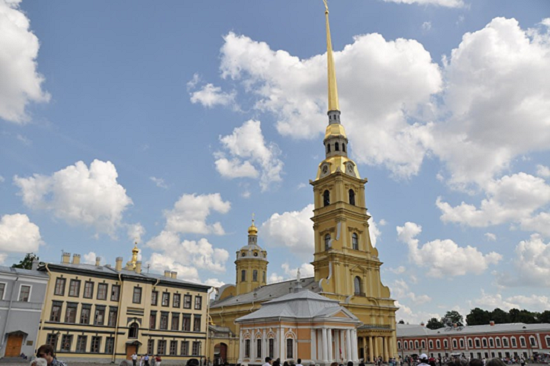
Peter and Paul Fortress
Next we drove to Petrodvorets, where Peter the Great built a summer palace on a sprawling estate by the water. The palace, called Peterhof (house of Peter) is surrounded by many gardens and some thirty other buildings spread over more than thousand hectares (2500 acres). There are dozens of fountains of all different styles, of which we were guided to a few on our walking tour of the estate. The gardens are well manicured and a walk through them stopping to see the many attractions was an exhilarating experience. Behind the palace is the grand cascade and Samson Fountain, a series of fountains cascading over steps, with the gilded statue of Samson opening the mouth of a lion. This symbolizes Russia’s victory over Sweden in the Great Northern War (lion is an element of Swedish coat of arms). Water shoots up from the lion’s mouth up to twenty feet. All the fountains are fed by springs at a higher elevation and operate by gravity (without any pumps). Eventually the water flows into the gulf in a long channel behind the palace.
The Palace is in the central part of the ensemble; its elegant three-story facade is flanked by Peterhof Church and Coat-of-Arms pavilion that can be seen from far away. The palace was not of this size and magnitude when originally built. Subsequent Tsar rulers added rooms and decors. The Palace and its rooms reflect the fashions and styles of each century. 18th century Baroque, 19th century Classical and rococo styles are seen. Moreover, the Palace was completely burnt by the occupying Nazis (during the 900 day siege of St. Petersburg - WWII). It has been yet again completely refurbished and returned to its original glory.
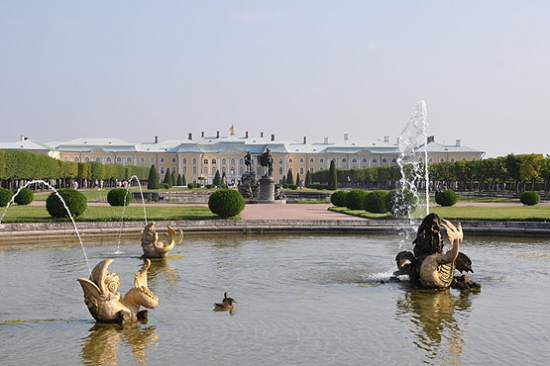
Peterhof
Peter had a son from his first wife, who was executed because of treason. Peter also married Catherine, an ordinary laundress. They had two daughters, Anna and Elizabeth. Because of Catherine’s commonality, the nobility did not accept her as Emperor’s wife and her children were considered to be illegitimate.
Peter died at 52 years of age from a bladder ailment. A very popular belief is that he died from jumping into icy water to save some drowning sailors but other historians do not substantiate this claim.
After Peter’s death, his wife Catherine I became the first female Tsarina but ruled only for two years. After her death, Peter’s grandson Peter II (the son of Peter’s executed son) ruled for another two years. Then there was a problem with succession, as they had no surviving male heir. After another ten years of rule by Peter’s niece, his daughter Elizabeth was finally accepted as the Tsarina. She was stunningly beautiful, elegant and fashionable. She soon built a reputation for herself as a spender.
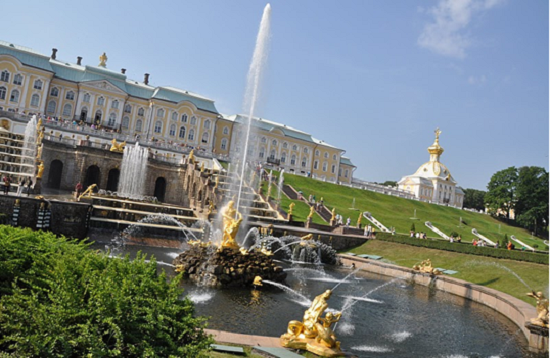
Cascade Fountains with Samson and the Lion
From Peter’s palace we traveled by water by hydrofoil back to St. Petersburg. Hydrofoil is a fast moving boat, which brought us right smack where the Hermitage and the Winter Palace were located. After the exhaustive walk along the gardens of Peterhof, we were ready for a quick nap. We disembarked and went straight back to the hotel to rest a bit and get ready for high tea.
High tea was arranged in the hotel restaurant, which was elegant with a glass roof. A variety of sandwiches, pastries and fruit with coffee were served. Needless to say the non-vegetarian sandwiches went untouched by our group. Following the high tea, we dressed up for a ballet performance in a theater, which was a walking distance from our hotel.
Tickets were handed out to us and we found our seats in the comfortable theater with greatly decorated stage and lovely chandeliers. The ballet we were going to see was the Swan Lake by Tchaikovsky. The ballet was so beautifully performed that every one of us was out of breath when it was over. We had a great view of the stage with some of the best seats in the house. The story and the performance moved us all. Fortunately, this version of the ballet had a happy ending (there are at least three different endings, I was told). The dancers defied gravity and the ballerinas with their graceful movements appeared like shimmering swans. I can never see another swan in a pond again without remembering the ballerinas, who looked like personifications of swans. We walked back to the hotel with light steps and I can assure you that we all felt a bit light, both in our hearts and weights.
The next day (ninth day of our trip) we drove a short distance from St. Petersburg to Tsarskoye Selo (Tsar’s Village). In 1937 the town was renamed Pushkin, after the great Russian poet. Tsars had been overthrown and the people in their bourgeois approach to life, and the hatred for the opulence of the Tsars, renamed the town Pushkin.
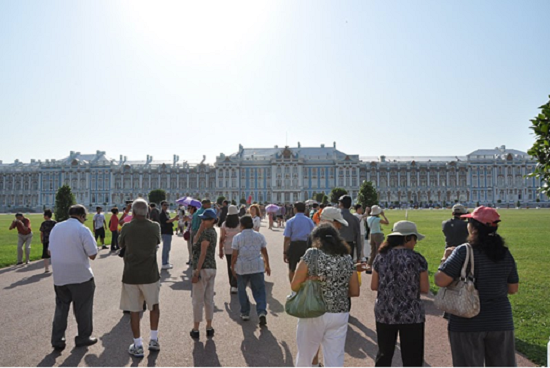
On the grounds of Catherine’s palace
This is the site of a grand palace that was started by Catherine I in a moderate fashion. But Elizabeth, who ruled for twenty years, expanded it extensively during her reign. She preferred the gilded Baroque look. She commissioned Italian Bartolomeo Rastrelli to expand the palace with new additions. Later, Tsarina Catherine II, who preferred the Classic style, remodeled many of the rooms, tearing down Elizabeth’s additions because she found it obscenely lavish. The final product, after many remodeling and rebuilding is an ostentatious, sprawling structure with many decorated halls. The most lavish of them are the Great Hall and the Amber Room. In addition there are many anterooms, the Arabesque room and several dining rooms, each decorated with different color. The original Amber panels are missing (whereabouts unknown) and the refurbished Amber Room is nonetheless breathtaking in its opulence and beauty.
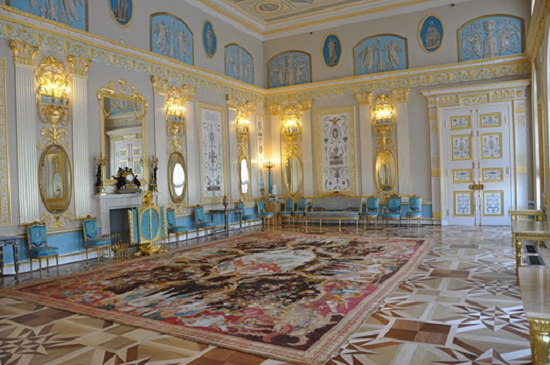
The Arabesque Room in Catherine’s Palace
Another Tsarina after Elizabeth, (alluded to earlier as Catherine II), also made history in Russia. Her name was also Catherine. Peter III succeeded Elizabeth. He was married to Catherine, the daughter of a German prince. Soon, she conspired to get rid of her husband and declared herself as the Tsarina. She came to be known deservedly as Catherine the Great and ruled Russia for 34 years. She greatly expanded Russian territories after winning many wars. Like all the Empresses, she liked luxury and pomp. She remodeled Catherine’s palace at Tsarskoye Selo in the classical style. She also completed the Winter Palace, which houses the Hermitage museum today, boasting one of the largest collections in the world.
Catherine the Great had one son Paul I, who also was considered to be a bastard, as Catherine herself claimed he was born to her lover and not her husband Peter III. Catherine and Paul did not have good relationship with each other. Paul even accused his mother of polluting his food with shredded glass in order to kill him. Perhaps, Catherine would have her son assassinated (as she disposed of her husband) but she was worried about the consequences. She did not see her son as a favored heir and took charge of two of his sons, Alexander and Nicholas, in order to groom them to become Emperors in his stead. However, Catherine died of a stroke in 1796, when Paul I became the Tsar. He promptly abolished the practice of a female member of the royal family from becoming the Empress and ruling Russia. From then on only male heirs were to be the Tsars. No doubt this action was due to the bitterness he held against his own mother. But it is also possible that he had seen the royal coffers drained of wealth by the erstwhile Tsarinas.
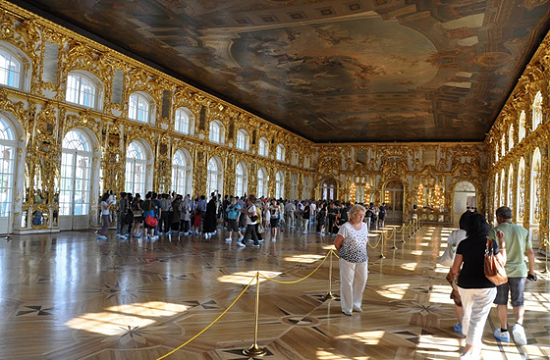
The Great Hall at Catherine’s Palace
Elizabeth effectively emptied the treasury in her spending spree. She is reputed to have worn a dress only once before throwing it away. She collected enormous numbers of treasures, gold and diamond laid jewelry, jewelry boxes and snuffboxes with intricate, delicate works, mirrors with heavy golden frames etc. We had a chance to see some of these treasures in the Gold Room at the Hermitage Museum later. Elizabeth also started the Winter Palace in St. Petersburg but unfortunately never had a chance to live there.
After our visit to the palace we had lunch in a quaint restaurant, with memorable meals prepared specially for us and we were the only guests. Live singers provided entertainment with guitars and cowboy hats. Meal was accompanied with wine and of course, chilled Vodka shots. We soon started believing that Russian drank more Vodka than water at any time of the day (and so did we).
We drove back to St. Petersburg and visited the Church of Our Savior on Spilled Blood. To understand this church and put it in perspective, we need to move slightly ahead in our understanding of the history. Paul I was on the throne for four years, four months and four days. He was assassinated in Catherine’s palace by his acquaintances, after a night of drinking and partying, in his own bedroom. Then the throne was thrust upon his 23 year-old son Alexander I.
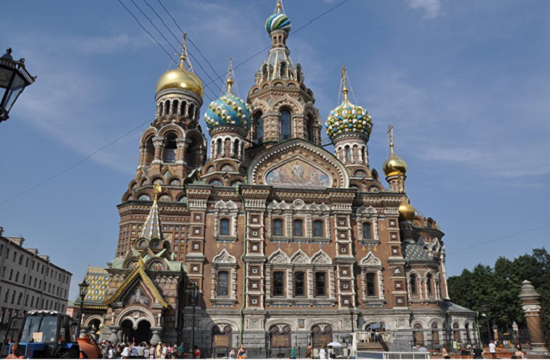
Resurrection Church on Spilled Blood
During his reign, Alexander I dealt the first major defeat to Napoleon in 1812. Following his mysterious death, he was succeeded by his brother Nicholas I, and then his son Alexander II. The new Tsar undertook many reforms and one of his controversial reforms was the emancipation of the serfs. This particular act was not well received either by the nobles or the peasants. He was fatally wounded (by a suicide bomber) on the streets of St. Petersburg. The church we were visiting was built on the very spot where the blood of the Tsar Alexander II had spilled and hence its strange name. In fact, inside the church there is a cordoned off area with some rocks with blood stains of the Tsar, and is treated as hallowed ground. The church is also called the Resurrection Church on Spilled Blood. Construction began during Alexander III reign and finished during Nicholas II period in 1907. It boasts of one of the largest collection of mosaics in its interior, depicting scenes of the Bible. The intricately detailed mosaics cover the entire ceiling and all the walls of the church, with each figure bordered with fine patterns, thus making them appear as prominent pieces of framed artwork. The architecture for the church took its inspiration from the St. Basil’s Cathedral in Moscow, with similar appearing cupolas, predominantly in the Baroque and Neoclassical style.
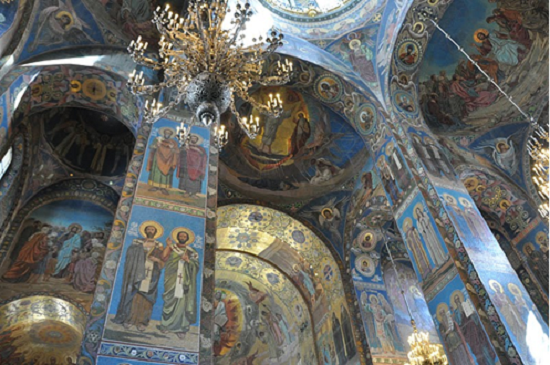
Interior of the Resurrection Church on Spilled Blood
The church had been ransacked during the Russian revolution and later used as a warehouse for vegetables (thus called Saviour on Potatoes in sarcasm). After the fall of communism, the church was restored and now functions as a museum. It opened its doors to the public after the fall of communism. It was a serene experience seeing the inside of the church. It was as beautiful inside as its unique cupolas and the mosaic covered walls on the outside.
That evening we had dinner at an Indian restaurant, courtesy of a couple traveling with us (this is something they both arrange in every trip with this group). Indian food available in St. Petersburg is not the best but we had a great time by singing nostalgic songs and one of our ladies who was proficient in Indian dance gave us a lovely interpretation in Bharata Natyam for the a south Indian song we were able croon. The harmonious movements and the esthetic expressions reminded me of the ballerinas in Swan Lake, which was still fresh in our memory. Indian classical dance is as graceful (and more expressive) as the ballet, I thought. It was also nice to see everyone take part in this evening of fun and frolic.
Next morning we had a late start to visit the Hermitage museum. The museum is world-famous in the same league as the Louvre in Paris and the Metropolitan Museum of Art in New York City. There are three million pieces of artifacts in the Hermitage. It is said that if one took a minute seeing every piece in the museum, it would take more than a dozen years to see everything.
Hermitage is located next to the Winter Palace of Catherine the Great. Elizabeth had begun the building process but she died before it was completed. It was Catherine who completed the palace and she was the first Tsarina to live there. She had a large collection of artwork that needed housing. Hermitage started as a small building with Catherine’s collection. Subsequently, over many decades, the collection grew so large that part of the Winter Palace was used to exhibit it. Now, of course, the entire palace and the original building of the Hermitage are used as the museum.
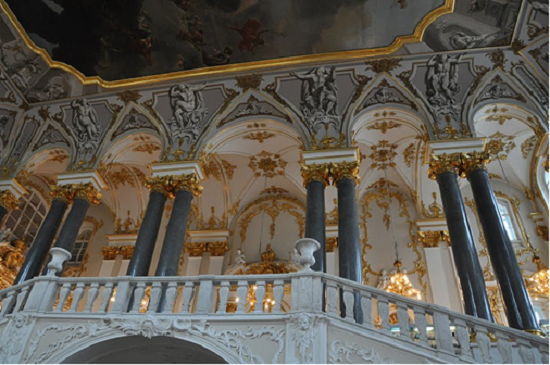
Entrance to Hermitage Museum
The museum was one of the highlights of our visit. And we were shown only a small part of the collection, mostly the highlights. It has the second largest collection of Rembrandt in the world. There is also an entire floor dedicated to the French impressionistic paintings. We saw many Monet, Renoir and Matisse. There were also several Pablo Picasso paintings hanging casually in well-lit rooms. The main attraction also contained lovely Leonardo da Vinci and Raphael masterpieces. We got to see many Vincent van Gogh classics as well. The artwork and the artifacts are very well displayed. We rushed through the collection at warp speed in order to see all that was relevant, taking as many pictures as we could. I made a mental note to myself that if I ever visited St. Petersburg once more, I would spend a leisurely, un-hurried walk through the Hermitage all over again.
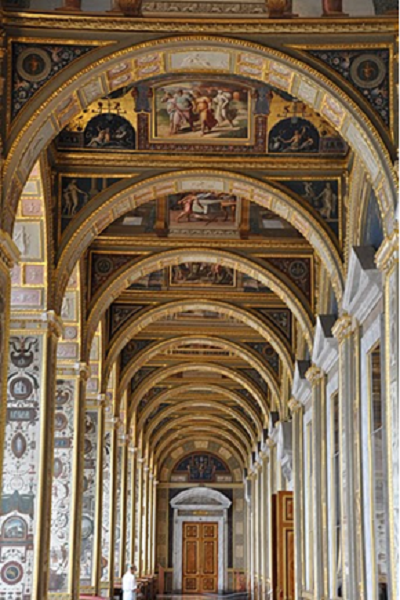
Raphael Loggia at Winter Palace and the Hermitage
We visited the Gold Room at the Hermitage by appointment. Only small groups are allowed at a time. It is no more than two or three rooms of display but every piece we saw was priceless. Photography was prohibited and it is difficult to describe the exhibits without using many adjectives. Gorgeous and priceless should suffice for now. Gold jewelry and artifacts with the most intricate design made of gold, with inlays of the most precious stones (and dozens of them in each piece) were glittering behind glass cages. Perhaps the most intricate of them all was the collection of Elizabeth. After seeing the collection, I knew exactly why she was called Elizabeth, the spender.
That night we had a sumptuous dinner in the hotel restaurant served by tuxedo wearing servers with white gloves. All of the servers were better dressed than most of us men, who were in our shirtsleeves. A 13-piece orchestra playing many Tchaikovsky and Mozart favorites accompanied a four-course meal with excellent wine. This was culminated by a couple of ballet dancers from the famed Marinsky Theater performing a short dance for us. We had a close look at the two dancers, performing graceful dance with the man showing his athleticism by performing incredible lifts, all in a fluid motion in step with live music. We went to bed well satisfied with that day.
I should say that we were very satisfied with our entire experience in St. Petersburg. I have heard of people who had fallen in love with Paris after their first visit. To me, it is St. Petersburg that I adored. I would like to come back here sometime and leisurely look at all these attractions. I will add it to my ‘Bucket List’ again.
On Day 11, we were to fly to Moscow for the final leg of our trip. We reached the airport at St. Petersburg and frankly we were all shocked. From the borders of a beautiful city we were transported “back to the future.” The airport is a relic of the old Soviet Communist power structure. The hallways were ominous and the airport was ghastly. It was a large airport building that lacked color and people. The airside waiting areas had asphalt on the floor and the bathrooms had no water. The walkway escalators were non-functional and the walls were a dull grey. It certainly reminded me of the buildings of the old Soviet era that we were used to seeing in movies, tasteless and intimidating. Perhaps it is the precursor to what we would see in Moscow, I thought. No more great boulevards and pristine landscapes with manicured buildings. No more exquisitely renovated palaces and refurbished churches. Are we going to the old dreaded headquarters of the now defunct Soviet Union, once called the evil empire, or will we be pleasantly surprised? With that question looming large in my mind, we took off from the St. Petersburg airport in an Aeroflot flight. It was with this apprehension we reached Moscow.
Continued to Moscow, Russia
12-Oct-2011
More by : Dr. Neria H. Hebbar